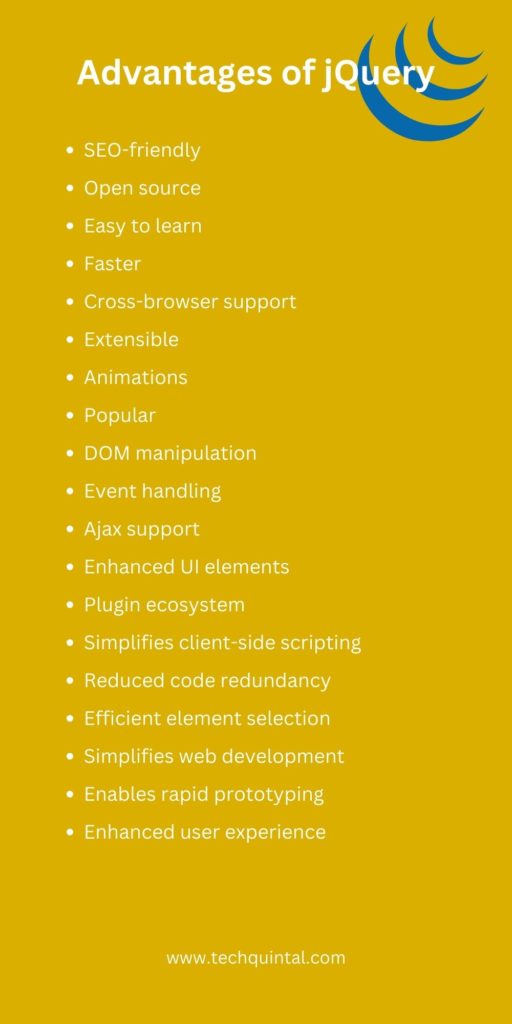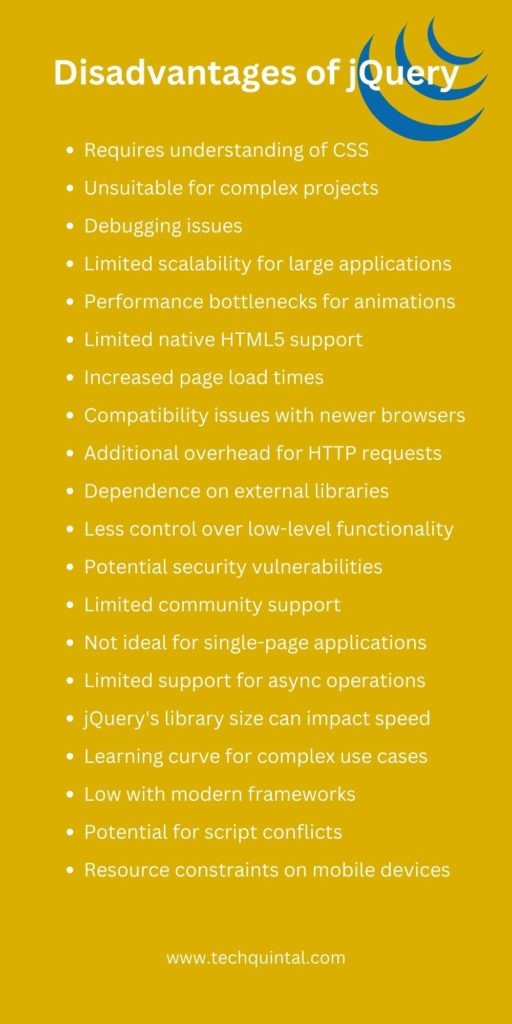
jQuery is a JavaScript library that is open-source in nature. If you don’t know what JavaScript is, be sure to brush up on that knowledge first. You might want to use jQuery to make the most of JavaScript. This library has a motto that goes, “write less, do more.” That’s exactly what you get, as it allows its users to become productive. Before we dive into the advantages and disadvantages of jQuery, let’s see how it helps us achieve this.
First, it wraps the JavaScript tasks in the form of methods. Then, at the time of writing the code, you can simply call these methods. This is kind of a bypass since you can skip writing tasks and alternatively call methods to achieve the same result. But as we all know, nothing is foolproof. Thus, let’s examine the pros and cons of jQuery.
Comparison Table of the Advantages and Disadvantages of jQuery
| Advantages | Disadvantages |
|---|---|
| SEO-friendly | Requires understanding of CSS |
| Open source | Unsuitable for complex projects |
| Easy to learn | Debugging issues |
| Faster | Limited scalability for large applications |
| Cross-browser support | Performance bottlenecks for animations |
| Extensible | Limited native HTML5 support |
| Animations | Increased page load times |
| Popular | Compatibility issues with newer browsers |
| DOM manipulation | Additional overhead for HTTP requests |
| Event handling | Dependence on external libraries |
| Ajax support | Less control over low-level functionality |
| Enhanced UI elements | Potential security vulnerabilities |
| Plugin ecosystem | Limited community support in recent years |
| Simplifies client-side scripting | Not ideal for single-page applications |
| Reduced code redundancy | Limited support for asynchronous operations |
| Document traversal | jQuery’s library size can impact speed |
| Efficient element selection | Overhead in cases of heavy animations |
| Simplifies web development | Learning curve for complex use cases |
| Enables rapid prototyping | Reduced relevance with modern frameworks |
| Enhanced user experience | Potential for script conflicts |
| Customizable with widgets | Resource constraints on mobile devices |
Advantages of jQuery
You can easily optimize jQuery for search engines. This is to say jQuery will let your websites be found effectively on the search engine. Consequently, it attracts more traffic, which makes the jQuery library SEO-friendly.

Also, pages load quickly (when optimized properly), which further enhances user interactions. From a user perspective, websites that have good response times are preferred over those that don’t. The following are the other benefits of using jQuery:
1. jQuery is Open source
jQuery is an open-source library, so you know what you are getting yourself into. Besides being transparent, it is free to use and backed up by huge community support. Whenever you encounter a problem, you can simply turn to them to get solutions.
Plus, you no longer have to worry about licensing issues that come along with the proprietary libraries. The open-source nature of jQuery gives you the flexibility to customize your website the way you want.
2. Easy to learn
The code of jQuery is legible, and that’s exactly what you need when starting. It has clean and simple syntax, allowing you to write effective code. At the same time, it allows you to identify your mistakes and rectify them.
When compared to other available options, you can use one line of code in jQuery instead of lengthy codes to achieve the same result. This is because it allows you to chain selectors and methods together for performing multiple tasks.
3. Faster
We have already seen how jQuery reduces the amount of code written to perform tasks. This means you can write multiple tasks in a line. Naturally, you will be able to perform tasks quickly. In other words, it is a lightweight library, where you can do more with less code. As a developer, if you want to boost your productivity, jQuery can be your go-to. It will save you time in development along with increasing efficiency.
4. Popular
According to the web technology surveys, jQuery is used by 78.5% of websites. This is equivalent to 95.4% of the JavaScript market share. Therefore, you might have gotten the idea it is one of the most popular JavaScript libraries, and you would be right.
There are various reasons for its wide acceptance. Firstly, it saves the cost as it cuts down the time spent on development. Secondly, it is simple and easy to use, which makes it a popular option in web development. Lastly, it offers effective solutions for JavaScript challenges.
5. Cross-browser support
Cross-browser issues are one of the primary nightmares for developers. They develop a website that works perfectly fine on one browser. However, when it comes to other browsers or different versions, the same website design elements collapse. This is a common issue when websites are developed using JavaScript only.
The introduction of jQuery helps deal with such issues. It allows you to develop websites that are supported on different browsers, as well as run smoothly on distinct versions.
6. Extensible
The plugins are supported in jQuery, so you can develop yours or use plugins from third parties. This way, you can easily introduce additional functionality to your project. The benefit of using plugins in jQuery is that you can save time as well as resources that are otherwise spent on creating those functionalities from scratch.
7. Animations
To add animations to your web pages, you require additional resources. But with jQuery, you can skip all these additional steps and instead use its animate method.
This method allows you to create animations for different web elements by animating the CSS values of objects. It is quite simple to use and developers/designers can apply animation to all animable values. That way, you can also reduce overload, which is, as we know, good for SEO too.
Disadvantages of jQuery
We have covered quite a few perks of jQuery so far. Now is the time to look at its drawbacks. The following is a list of downsides of jQuery.

1. jQuery Requires an understanding of CSS
Cascading Style Sheets (CSS) is used to build webpages, but it is also a prerequisite of jQuery. You should at least know the fundamentals of CSS to develop websites using jQuery. The understanding of CSS selectors such as classes and IDs is another imperative. This is a major drawback that holds the wannabe developers from tapping the potential of jQuery.
2. Unsuitable for complex projects
The Document Object Model (DOM) is the application programming interface (API) for HTML, XHTML, or XML documents that is manipulated in jQuery. In fact, jQuery is used for easy DOM manipulation.
However, when it comes to developing complex projects, you’ll find the features of jQuery to be limited. This further makes them unsuitable for large and sophisticated projects, where you would require additional resources.
3. Debugging issues
Continuing the above point, when you develop complex projects, you need to add more libraries and plugins to get extra features. As the number of libraries and plugins increases, the size and dependencies also grow. This results in chaos, and you can experience the negative effects more when you encounter an issue. In other words, you will have a hard time debugging because of the intricacies.
4. Limited scalability
As your application grows, you might find it difficult to scale your jQuery code. Even though jQuery is made with usability in mind, sometimes it can cause issues with your development progression. Especially if you have a lot of complex JS concepts implemented, you should consider a better alternative.
5. Increased page load times
jQuery makes development a lot faster. But, there is a catch. If you are serving millions of users simultaneously, loading jQuery library for each one of them will increase the page load times. Even though you can tackle this issue with the use of a CDN, it will still consume your valuable bandwidth. So, it is better to stick with vanilla JS.